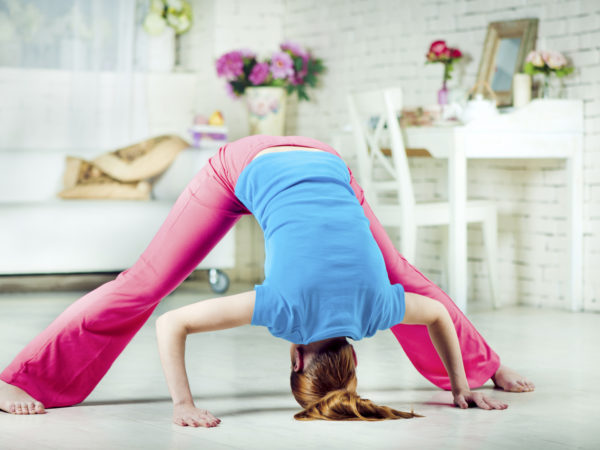Wide-Legged Forward Bend

“I enjoy the deep stretch provided by the Wide-Legged Forward Bend – it’s definitely one of my favorite yoga poses.” – Andrew Weil, M.D.
Description & History
The Wide-Legged Forward Bend, known as Prasarita Padottanasana in Sanskrit, is a standing forward bend that provides stretching for the neck, back, calves and hamstrings. The pose name comes from the words prasarita meaning stretched out, pada meaning foot, uttana meaning intense stretch, and asana meaning posture.
How to Perform the Wide-Legged Forward Bend
- Start in Tadasana, or standing position with your legs shoulder-width apart and arms at side. Place your feet three to four feet apart depending on your height (taller people should take a wider stance) and rest your hands on your hips. Turn your toes in slightly, make sure your feet are parallel with each other, engage your thigh muscles and lift your chest up making your torso longer than your back.
- Exhale and lean forward from the hips maintaining the length of the front torso. Once your torso is about parallel to the floor, extend your arms straight and press your fingertips into the floor directly below your shoulders for support. Fingertips should be pointing forward.
- Push your pelvis upward and with support from your arms, slowly lower your torso to the floor.
- Continue bending at the hips until you can rest the crown of your head on the floor and your elbows are bent at a 90-degree angle.
- Hold this pose for 30 seconds to one minute. To come out of the pose, push your hands into the floor and engage the muscles of the lower back to bring the torso up. Stand up straight and jump back to Tadasana and rest.
Potential Health Benefits
- Stretches and strengthens the back muscles and inner leg muscles
- Improves digestion and organ health
- Relieves mild backache
- Relieves stress and calms brain
- Reduces the effects of mild depression and fatigue
A 2012 study published in the Journal of Bodywork and Movement Therapies looked into the effect of yoga exercises on arterial hypertension. The Wide-Legged Forward Bend was one of the yoga poses incorporated into this study. After the four-month study was completed, researchers found that the participants in the yoga group showed significant reduction of blood pressure, heart and respiratory rate compared to the control group. While it is recommended you take caution with performing the Wide-Legged Forward Bend if you have heart problems, when done correctly and slowly, the pose can provide health benefits.
Modifications & Variations
If you are a beginner and trying this pose for the first time, you may find you lack the flexibility to perform it without assistance. One way to provide support is to use a yoga block (a block made of lightweight, supportive latex foam]. When you are in the Wide-Legged Forward Bend, rest your hands on the yoga block instead of the floor in order to relieve unnecessary stress on your hips and lower back. After you become more flexible and are able to touch the floor unassisted with your hands but you cannot touch the crown of your head to the floor, continue using the yoga block. Rest your head on the yoga block until you are able to achieve the full pose. A thickly folded blanket can also be substituted for the yoga block.
A more advanced variation of the Wide-Legged Forward Bend is to bring your hands behind your back in what is called Prstanjali Mudra. This is where you bring the palms of your hands together with fingers extended. It is like Anjali Mudra but behind the back. If you are unable to achieve this variation of the pose, you can cross your arms behind your back and grab the opposite elbow.
Precautions
Consult with your physician before performing the pose if you have any of the following:
- Back injury including herniated discs
- High blood pressure or low blood pressure.
The Wide-Legged Forward Bend is a basic yoga pose but can cause more harm than benefit if you experience heart problems. If you have high or low blood pressure or are experiencing back pain, use caution when performing the Wide-Legged Forward Bend. A closely related yoga pose, the Seated Forward Bend, provides many of the same health benefits but with less stress placed on the head and back.
Related Poses
- Downward-Facing Dog Pose (Adho Mukha Svanasana)
- Standing Forward Bend Pose (Uttanasana)
- Seated Forward Bend Pose (Paschimottanasana)
Reviewed by: James Nicolai, M.D., on May 21, 2013
Sources
Mizuno, Julio, and Henrique Luiz Monteiro. “An assessment of a sequence of yoga exercises to patients with arterial hypertension.” Journal of bodywork and movement therapies (2012).









